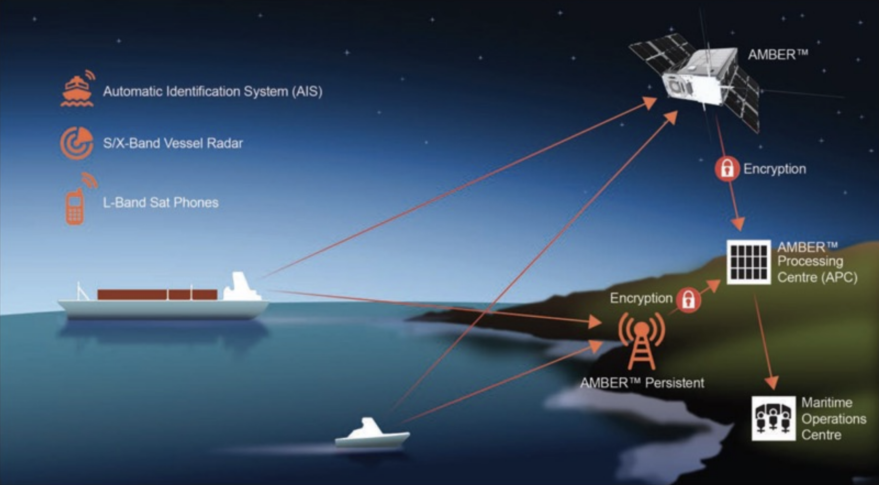(Xinhua) May 20, 2021

The black and white image taken by an obstacle avoidance camera installed in front of the rover of China's Mars probe Tianwen-1 shows that a ramp on the lander has been extended to the surface of Mars. The terrain of the rover's forward direction is clearly visible in the image, and the horizon of Mars appears curved due to the wide-angle lens. (Photo provided by the China National Space Administration)
BEIJING, May 19 (Xinhua) -- Two photos and two videos captured by China's Mars probe Tianwen-1 during and after the country's first landing on the red planet were released by the China National Space Administration (CNSA) on Wednesday.
The lander carrying a rover of the Tianwen-1 mission touched down in the southern part of Utopia Planitia, a vast plain on the northern hemisphere of Mars, on May 15, becoming the country's first probe to land on a planet other than Earth.
The first photograph, a black and white image, was taken by an obstacle avoidance camera installed in front of the Mars rover. The image shows that a ramp on the lander has been extended to the surface of Mars. The terrain of the rover's forward direction is clearly visible in the image, and the horizon of Mars appears curved due to the wide-angle lens.
The second image, a color photo, was taken by the navigation camera fitted to the rear of the rover. The rover's solar panels and antenna are seen unfolded, and the red soil and rocks on the Martian surface are clearly visible in the image.
Videos taken by a camera on the orbiter of Tianwen-1 show how the lander and the rover separated from the orbiter during landing. (Videos provided by the China National Space Administration)
The probe also sent back two videos taken by a camera on the orbiter, showing how the lander and the rover separated from the orbiter during landing.
Tianwen-1, consisting of an orbiter, a lander and a rover, was launched on July 23, 2020. It was the first step in China's planetary exploration of the solar system, with the aim of completing orbiting, landing and roving on the red planet in one mission.
After landing last Saturday, the lander and rover established communication with the Earth.
On May 17, the orbiter entered orbit to relay communication between the rover and the Earth, and sent back images and data from the rover.
The rover is now making preparations for moving down from the lander onto the Martian surface, CNSA said.
"The data that Zhurong (China's first Mars rover) will bring back to China would be of great interest to the scientific communities, be it in Europe, in China or anywhere," said an expert of the European Space Agency.
PARIS, May 19 (Xinhua) -- Europe-China cooperation in outer space is of great importance and creates bridges between scientists of the two sides, a senior official and expert of the European Space Agency (ESA) has said, expecting more cooperation and exchanges in this field.
In an interview with Xinhua on Monday, Karl Bergquist, ESA's administrator of international relations, said the agency, which has been cooperating with Chinese scientists in space exploration over the past years, is closely following the development of China's Mars mission.
The Tianwen-1 probe carrying China's first Mars rover Zhurong, named after the god of fire in ancient Chinese mythology, successfully touched down on the Red Planet on Saturday morning. It is the first time China has landed a probe on a planet other than Earth.

Technical personnel work at the Beijing Aerospace Control Center in Beijing, capital of China, May 15, 2021. (Xinhua/Jin Liwang)
Bergquist called the landing "a fantastic achievement" because landing on Mars is a highly complex and difficult task and what China has done is something which has never been done before -- succeeding to land in the first attempt.
"We really would like to congratulate China on this great achievement," he said.
"The data that Zhurong will bring back to China would be of great interest to the scientific communities, be it in Europe, in China or anywhere," the ESA expert added.
The expert said the European agency had provided environmental data on Mars to the China National Space Administration in 2015. It has also offered telemetric and tracking support for the Mars exploration mission.
As to a future Mars mission, a sample return one, Bergquist believed it will come in several years because of its enormous complexity. He is looking forward to more cooperation between European and Chinese scientists in this domain.

Technical personnel celebrate at the Beijing Aerospace Control Center in Beijing, capital of China, May 15, 2021. (Xinhua/Rao Aimin)
For decades, European and Chinese space scientists have been working together in various domains, the expert said, citing the Solar wind Magnetosphere Ionosphere Link Explorer, or SMILE, a joint mission between the ESA and the Chinese Academy of Sciences which aims to build a more complete understanding of the Sun-Earth connection by measuring the solar wind and its dynamic interaction with the magnetosphere.
"This is a very interesting mission. The purpose of such a mission is providing data to European and to Chinese researchers so that they can work together to understand and learn more about the universe," he said.
Bergquist also highlighted Europe-China cooperation in the field of earth sciences, introducing the "dragon" project that has been going on for over 10 years with about 700 scientists from the two sides working together on issues including oceans, atmosphere, chemistry, pollution and climate.
"These are really fields that we have global problems (with) and we try to see how we can work together to find a solution for us all," Bergquist said.
"This is fantastic. We are pushing science a little bit further each time through these cooperation projects," he added.
(Web editor: Shi Xi, Liang Jun)









